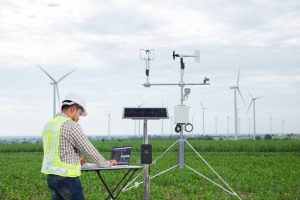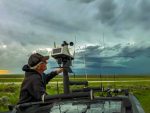| Meteorologist Key Stats | |
|---|---|
| Avg. Salary / year | $103,980 |
| Avg. Pay / hour | $49.99 |
| Education | 4+ Years |
| Job Outlook | 8% |
| Total Employed | 8,780 |
Meteorologists study weather patterns and natural events, and use the data they collect to provide forecasts and weather warnings.
If you’re interested in geography, climate, and sciences and have an aptitude for academic learning, then you may enjoy a career as a meteorologist.
Working as a meteorologist, you will be studying the atmosphere, its behaviors, and patterns.
Using a wide range of equipment and methodology, you will learn to identify weather patterns and trends, as well as predict likely outcomes.
Most meteorologists work to provide weather reports all around the world.
Some specialize in particular areas, such as natural disasters, others work in research or are employed in the academic world as professors.
Go to Page Section:
Education Requirements to Become a Meteorologist
When you become a meteorologist it’s never too early to start.
If you’re still in high school you should take subjects in the sciences, as well as mathematics, and geography.
Academic skills in mathematics and physics are essential, since you’ll need to make good grades to get a place in college.
You might also like to get some experience at this stage.
While it’s somewhat unlikely that you could work part-time with meteorologists, you may be able to do some work experience there if your school runs a program like this.
Volunteering with local community groups with an interest in the environment is a good idea.
You’ll need to complete a four year bachelor of science while at college with a major in meteorology.
There are only about 20 schools in the country that offer these courses.
Competition is high, and you may also need to move to complete your studies.
If you can’t attend one of these schools, your next best option is to major in physics and take as many meteorology subjects as you can.
This will allow you access to a limited amount of jobs in meteorology, or act as pathway to postgraduate studies in the field.
It’s a good idea at this point to decide on what sector of meteorology you want to work in.
for example, some meteorologists work in television, others in research, while some work on the field.
Choosing elective subjects in complementary can help.
Internships are important, and if you have the opportunity you should take them up during your time at college.
Not only is it excellent work experience, but it makes a good addition to your resume, and may even lead to a job later on.
Meteorologist Job Description
Meteorologists can be divided into two categories; operational and theoretical.
Operation meteorologists are involved in the active side of the job, such as providing forecasts.
Their duties involve monitoring a range of testing equipment, analyzing data, and preparing reports.
Theoretical meteorologists spend their time involved with research.
This could involve conducting studies into weather patterns, creating new models, and writing papers and reports.
They may be required to travel as a part of their work, or spend time out on the field.
Many theoretical meteorologists are employed within education, and also teach at colleges as a part of their role.
Some typical duties of a meteorologist include:
- Running tests and operating equipment
- Maintaining databases
- Providing weather forecasts
- Providing weather warnings
- Writing academic papers
- Conducting studies into weather
- Teaching
Meteorologist Salary and Career Path
After finishing college, meteorologists may find work for government departments, private weather prediction firms, in colleges and universities, news stations, or in other research facilities.
The type of work a candidate is looking for will have an effect on their place of employment.
Meteorologists that work in research will have much more predicable hours than forecast meteorologists, who may be required to work evenings and weekends.
In the event of a disaster, they may be called in to work unexpectedly.
While many meteorologists start their career in forecasting, many move on to work in research and education later.
Some become weather consultants, providing a specialist service to places like airports, or owners of tall buildings, who require their expertise.
The median salary for a meteorologist is $85,000.
The lowest paid 10% earn around $55,000 a year, while the 10% highest paid in the field earn more than $127,000.
Meteorology provides an interesting and rewarding career for those that have a passion and interest in natural science and weather phenomenon.
To become a meterologist, there is quite a bit of education required, however if you are interested in this work then you will find your time at college enjoyable.
Employment is secure and the salary available for meteorologists is quite good.
![]() The below information is based on the 2024 BLS national averages.
The below information is based on the 2024 BLS national averages.
National Average Salary
$103,980Average Salary by State
| State | Avg. Annual Salary |
|---|---|
| Alabama | $87,450 |
| Alaska | $104,660 |
| Arizona | $95,590 |
| Arkansas | $99,730 |
| California | $121,620 |
| Delaware | - NA - |
| District of Columbia | $139,730 |
| Florida | $99,160 |
| Georgia | $97,060 |
| Hawaii | $120,620 |
| Idaho | $111,770 |
| Illinois | - NA - |
| Indiana | $132,370 |
| Iowa | $81,210 |
| Kansas | $82,970 |
| Kentucky | $77,110 |
| Louisiana | $105,980 |
| Maine | $104,360 |
| Maryland | $118,890 |
| Massachusetts | - NA - |
| Michigan | $101,700 |
| Minnesota | - NA - |
| Mississippi | $77,670 |
| Missouri | $113,740 |
| Montana | $103,370 |
| Nebraska | $103,260 |
| Nevada | $115,560 |
| New Hampshire | $67,400 |
| New Jersey | $118,520 |
| New Mexico | $109,840 |
| New York | $131,440 |
| North Carolina | $108,690 |
| North Dakota | $90,360 |
| Ohio | $91,560 |
| Oklahoma | $91,200 |
| Oregon | $124,830 |
| Pennsylvania | $91,970 |
| South Carolina | $98,460 |
| South Dakota | $92,300 |
| Tennessee | $109,970 |
| Texas | $92,860 |
| Utah | $71,250 |
| Virginia | $124,270 |
| Washington | $104,290 |
| West Virginia | $70,020 |
| Wisconsin | $105,040 |
| Wyoming | $88,120 |
| Puerto Rico | $74,630 |
The highest-paying state in this field is District of Columbia, with an average salary of $139,730.
Here are the five states with the highest salaries in the field:
* Employment conditions in your area may vary.
Frequently Asked Questions
What does a meteorologist do?
Meteorologists are scientists who use scientific principles to forecast how the earth’s atmosphere affects the planet and everyone on it.
There are a few different types of meteorologists – operational, atmospheric, forensic, broadcast, synoptic, physical, consulting, research, environmental, archive and research meteorologists.
Scientists can also work as teachers or professors.
Meteorologists usually work for consulting businesses, TV/radio stations, the military, educational facilities, and the National Atmospheric and Oceanic Administration.
Depending on the specialization, the typical duties of a meteorologist will differ.
Climate meteorologists (or climatologists), for example, help predict future climate trends by looking at long term weather patterns and data from hundreds or even millions of years ago.
Operational meteorologists study wind speed, direction, humidity, air pressure, and temperature, and so on.
How much do meteorologists make?
On average, a meteorologist can make a little less than $43.000 per year in the United States.
In case you decide to follow this career path, you can expect to earn anywhere between $30.000 and $109.000 annually.
The salary would certainly depend on a variety of factors – your education and experience level, the employer, the location and so on.
The meteorologists that work in Alaska, Oklahoma, and Texas, for example, have the highest average salaries.
How much does it cost to become a meteorologist?
In most cases, you would have to obtain at least a bachelor’s degree in meteorology or atmospheric science, in order to become a meteorologist.
A year in a university can cost you anywhere between $8.000 and $45.000 (and more); the cost depends on a variety of factors (the books, supplies, and accommodation expenses are not included).
However, the more advanced roles will require you to have a master’s degree (between $30.000 and $120.000) or a doctorate degree (around $30.000 per year).
A Ph.D. is a must if you want to teach or conduct independent research.
What is the demand for meteorologists?
Between 2018 and 2028, the atmospheric scientist (including meteorologists) job market is expected to grow by 8%, according to the Bureau of Labor Statistics.
That is a little faster than the national average for all occupations in the United States.
Job opportunities will be best for those candidates who possess a master’s or a doctorate degree.
The best job prospects will be provided by the private industry.
How long does it take to become a meteorologist?
It will take you 4 years to obtain a bachelor’s degree, 2-3 years to acquire a master’s degree, and anywhere between 4 and 6 years to earn a Ph.D.
The sooner you decide what sphere you want to work in, the better.
Depending on your area of interest, you might be required to take some classes in journalism, computer science, or chemistry, for example.
Any type of related experience and internships will help you find a job in the future.














